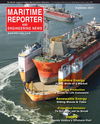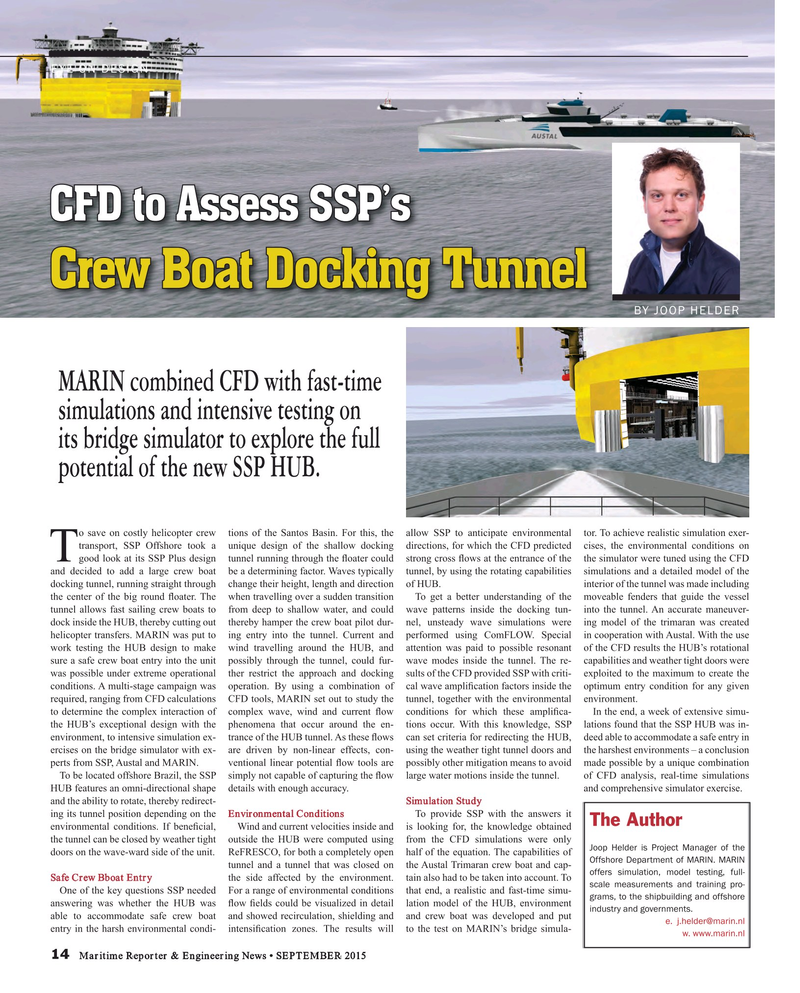
Page 14: of Maritime Reporter Magazine (September 2015)
Offshore Energy Technologies
Read this page in Pdf, Flash or Html5 edition of September 2015 Maritime Reporter Magazine
EYE ON DESIGN
CFD to Assess SSP’s CFD to Assess SSP’s
Crew Boat Docking TunnelCrew Boat Docking Tunnel
BY JOOP HELDER
MARIN combined CFD with fast-time simulations and intensive testing on its bridge simulator to explore the full potential of the new SSP HUB.
o save on costly helicopter crew tions of the Santos Basin. For this, the allow SSP to anticipate environmental tor. To achieve realistic simulation exer- transport, SSP Offshore took a unique design of the shallow docking directions, for which the CFD predicted cises, the environmental conditions on
Tgood look at its SSP Plus design tunnel running through the ? oater could strong cross ? ows at the entrance of the the simulator were tuned using the CFD and decided to add a large crew boat be a determining factor. Waves typically tunnel, by using the rotating capabilities simulations and a detailed model of the docking tunnel, running straight through change their height, length and direction of HUB. interior of the tunnel was made including the center of the big round ? oater. The when travelling over a sudden transition To get a better understanding of the moveable fenders that guide the vessel tunnel allows fast sailing crew boats to from deep to shallow water, and could wave patterns inside the docking tun- into the tunnel. An accurate maneuver- dock inside the HUB, thereby cutting out thereby hamper the crew boat pilot dur- nel, unsteady wave simulations were ing model of the trimaran was created helicopter transfers. MARIN was put to ing entry into the tunnel. Current and performed using ComFLOW. Special in cooperation with Austal. With the use work testing the HUB design to make wind travelling around the HUB, and attention was paid to possible resonant of the CFD results the HUB’s rotational sure a safe crew boat entry into the unit possibly through the tunnel, could fur- wave modes inside the tunnel. The re- capabilities and weather tight doors were was possible under extreme operational ther restrict the approach and docking sults of the CFD provided SSP with criti- exploited to the maximum to create the conditions. A multi-stage campaign was operation. By using a combination of cal wave ampli? cation factors inside the optimum entry condition for any given required, ranging from CFD calculations CFD tools, MARIN set out to study the tunnel, together with the environmental environment.
to determine the complex interaction of complex wave, wind and current ? ow conditions for which these ampli? ca- In the end, a week of extensive simu- the HUB’s exceptional design with the phenomena that occur around the en- tions occur. With this knowledge, SSP lations found that the SSP HUB was in- environment, to intensive simulation ex- trance of the HUB tunnel. As these ? ows can set criteria for redirecting the HUB, deed able to accommodate a safe entry in ercises on the bridge simulator with ex- are driven by non-linear effects, con- using the weather tight tunnel doors and the harshest environments – a conclusion perts from SSP, Austal and MARIN. ventional linear potential ? ow tools are possibly other mitigation means to avoid made possible by a unique combination
To be located offshore Brazil, the SSP simply not capable of capturing the ? ow large water motions inside the tunnel. of CFD analysis, real-time simulations
HUB features an omni-directional shape details with enough accuracy. and comprehensive simulator exercise. and the ability to rotate, thereby redirect- Simulation Study ing its tunnel position depending on the Environmental Conditions To provide SSP with the answers it
The Author environmental conditions. If bene? cial, Wind and current velocities inside and is looking for, the knowledge obtained the tunnel can be closed by weather tight outside the HUB were computed using from the CFD simulations were only
Joop Helder is Project Manager of the doors on the wave-ward side of the unit. ReFRESCO, for both a completely open half of the equation. The capabilities of
Offshore Department of MARIN. MARIN tunnel and a tunnel that was closed on the Austal Trimaran crew boat and cap- offers simulation, model testing, full-
Safe Crew Bboat Entry the side affected by the environment. tain also had to be taken into account. To scale measurements and training pro-
One of the key questions SSP needed For a range of environmental conditions that end, a realistic and fast-time simu- grams, to the shipbuilding and offshore answering was whether the HUB was ? ow ? elds could be visualized in detail lation model of the HUB, environment industry and governments. able to accommodate safe crew boat and showed recirculation, shielding and and crew boat was developed and put e. [email protected] entry in the harsh environmental condi- intensi? cation zones. The results will to the test on MARIN’s bridge simula- w. www.marin.nl 14 Maritime Reporter & Engineering News • SEPTEMBER 2015
MR #9 (10-17).indd 14 MR #9 (10-17).indd 14 9/4/2015 9:45:45 AM9/4/2015 9:45:45 AM

 13
13

 15
15
